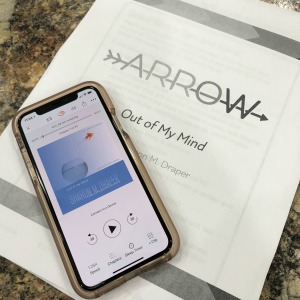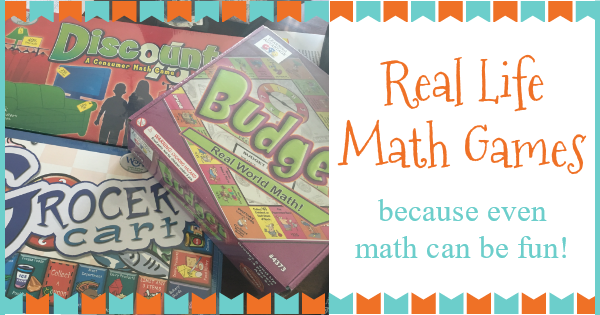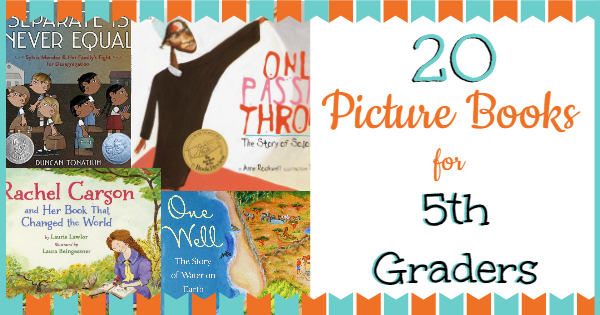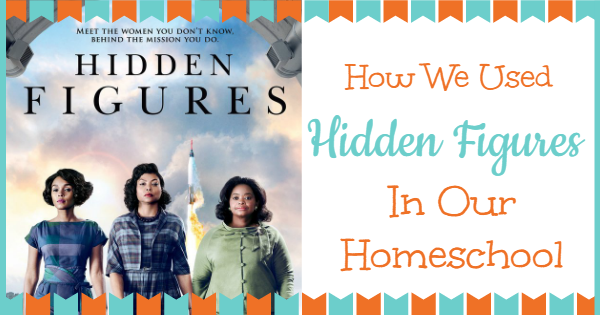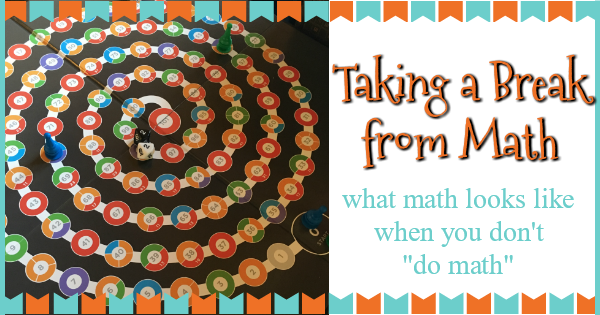Yesterday I reviewed Grocery Cart, another real life math game. Last night, after a long day working at the barn, Hanna and I sat down with dinner and Budget. I’ll be honest, I don’t love this game as much as Grocery Cart, but it’s a good game, and there’s TONS of learning going on.
Here’s how you play.
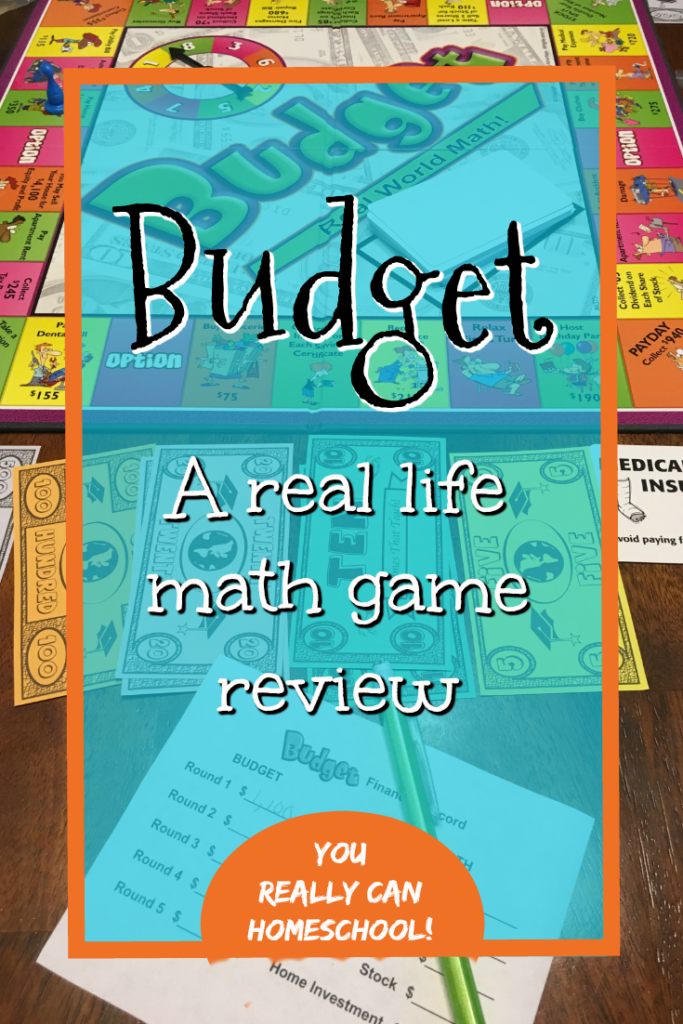 To start this real world math game each person puts $2,500 in their bank account. You must buy one option before the game starts. The options include different types of insurance, a house, stocks, bonds… things like that. The option you buy at the beginning, we noticed, can make or break your game… so talk about it and choose wisely.
To start this real world math game each person puts $2,500 in their bank account. You must buy one option before the game starts. The options include different types of insurance, a house, stocks, bonds… things like that. The option you buy at the beginning, we noticed, can make or break your game… so talk about it and choose wisely.
Next you choose your budget for the round. This is best done by looking at the board, noticing what types of payments you may land on and have to pay. You can guess this part… or if you want to work on your probability skills there is actually a probability worksheet to see what the probability of hitting each of the payments on the board is. We willy nillied it. 😉 I think it’s pretty awesome they added that sheet in there. There’s only one, so you’ll need to make copies to keep the original clean. (Same with the budget forms).
Once you’ve decided on a budget for round one decide on how much savings you need for the game to end. The game recommended 6k, we lowered it to 5k and quit after 4 rounds.
To begin you spin the spinner, and move your pawn. I got this game, as I mentioned in my Grocery Cart review, because I hated PayDay so much. What I really like about this game is the payments are realistic, and the things you would expect to pay for in real life. The game is set up to be pretty true to life. Sometimes you do have a fire and it costs you a lot of money even if you don’t have the money in your budget (or the bank for that matter). I appreciated that element. The game is really well designed.
If you manage to stay within your budget you get a bonus when you hit the payday spot on the board. The closer you are to your budget the larger your bonus (to keep people from using their whole bank as their budget.)
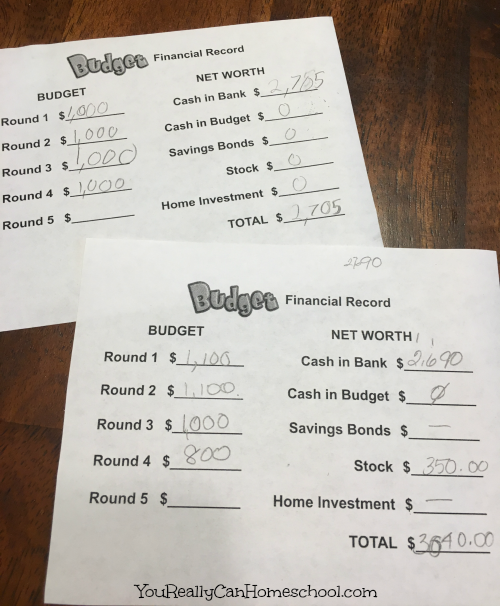 I’m not sure if we weren’t playing it exactly the right way, but it seemed hard to save money (yes, I get the irony there!) (if their goal is to save 6K to stop game play, and you only have 5 rounds on the budget card). We ended after 4 rounds and you can see neither of us was near 6k cash in the bank. We didn’t land on options cards all that often, and when we did we decided not to buy quite a few things lol. However, I did choose to buy stock in a round when I couldn’t really afford it. I blew my budget that round, didn’t get the “budget bonus”, but ended up winning the game because of the value of my stock when I added up my net worth at the end of the game.
I’m not sure if we weren’t playing it exactly the right way, but it seemed hard to save money (yes, I get the irony there!) (if their goal is to save 6K to stop game play, and you only have 5 rounds on the budget card). We ended after 4 rounds and you can see neither of us was near 6k cash in the bank. We didn’t land on options cards all that often, and when we did we decided not to buy quite a few things lol. However, I did choose to buy stock in a round when I couldn’t really afford it. I blew my budget that round, didn’t get the “budget bonus”, but ended up winning the game because of the value of my stock when I added up my net worth at the end of the game.
When you’ve reached your predetermined goal to end the game, you add up all your money in the bank, money left in your budget as well as your assets and whoever has the highest net worth wins the game.
That’s how you play. It’s pretty straight forward.
We did have some questions/issues with the game though.
If your kiddo is the banker they will be doing a LOT of money handling and counting. 🙂 I thought it was a little strange they provided so many 500 dollar bills in the game, but not as many 100 dollar bills. We almost ran out of money in the bank a couple times, and I’m not sure how you would have enough money if you were playing with 4 players. (But again, we could have been doing something wrong lol.)
I also found it interesting, because it seemed from the directions you should reevaluate your budget each round, but Hanna kept the same budget each month, I changed mine a couple times, but I would have been better off if I kept it the same. Maybe because we didn’t add a lot of options… I guess if one of us had bought a house we would have had to rethink our budget and the possible payment spots we could have landed on that we would have had to pay with a house.
All in all, this game felt a lot like Monopoly to me (kind of burdensome and not all that much fun), but it was excellent for math practice, and the kiddo enjoyed it (she also loves Horseopoly). She said she didn’t like it as much as she liked Grocery Cart (we really loved that one!), but it was fun.
One thing I didn’t mention, if you feel strongly about knowing how games fit in with standards etc… this game has it written right at the top of the directions. It shows you exactly what Common Core standards are met with the game, Grocery Cart has this too. Honestly, I didn’t even look at what they were, but there’s a lot of financial literacy and math practice going on in this game. 🙂 We’ve got one more game, Discount, to review in this series of real life math games so stay tuned!
Your turn! Join us in my Secular, Relaxed-Eclectic Homeschooling with Older Kids group on Facebook and tell us your favorite game to play!!









